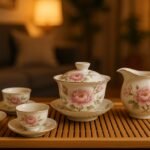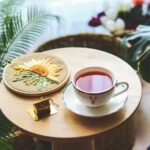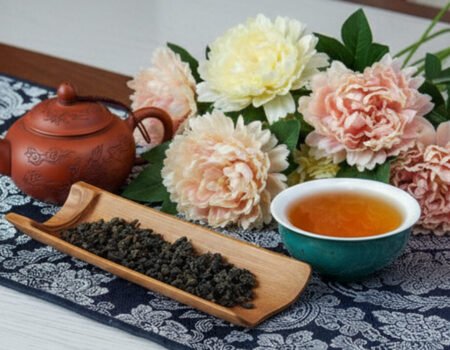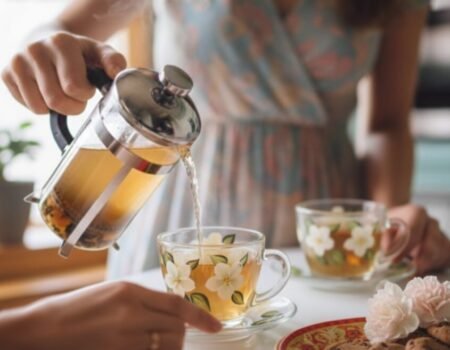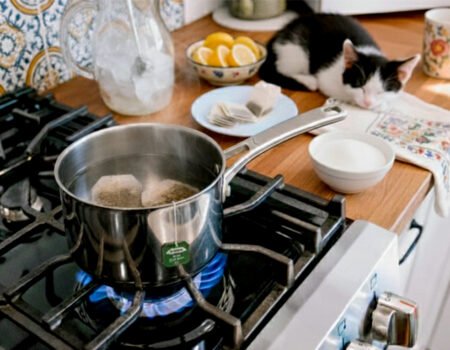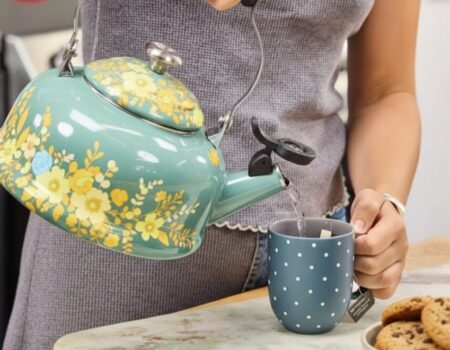
The Ultimate Guide to Tea Brewing Vessels: Brew Your Perfect Cup with Teaware
Index
Finding the right tea brewing vessels is crucial when you want that perfect cup. Tea lovers worldwide use more than 25 different types of teaware to craft their favorite drinks.
This guide will walk you through the most popular brewing vessels, from classic teapots to modern infusers, helping you match each tool to your tea type. Get ready to transform your tea experience.
Key Takeaways
- Different tea vessels impact flavor—glass works best for green and white teas, while Yixing clay enhances oolongs and pu-erh teas.
- Match vessel size to your needs: small 90ml pots for gong-fu style brewing and larger 600ml teapots for serving groups.
- Material matters—ceramic retains heat well, glass lets you watch leaves unfurl, and clay absorbs tea oils over time to enhance flavor.
- Water quality affects taste significantly, making up over 95% of your tea; avoid reboiling water as it loses oxygen and creates flat-tasting tea.
- Clean teaware properly by using only warm water for unglazed ceramic, mild soap for glass, and vinegar for removing mineral deposits from metal infusers.
Exploring Different Types of Tea Brewing Vessels.

Tea brewing vessels come in many shapes and sizes, each designed for specific tea types and brewing styles. From traditional clay pots to modern glass infusers, your choice of teaware affects both flavor and experience.
Teapots: Traditional and Modern Styles
Teapots have evolved dramatically since their origins in China during the Tang Dynasty (618-907 AD). Traditional designs showcase the rich history of tea culture, from simple clay vessels to the ornate porcelain sets popular during Victorian times.
Modern teapots offer exciting innovations while respecting these classic roots. You’ll find contemporary options in stainless steel, heat-resistant glass, and durable ceramics that blend function with style.
Many tea drinkers prefer specific materials based on the type of tea they brew most often.
The size and shape of your teapot directly impacts your brewing experience. Large pots work well for serving groups, while smaller vessels excel for gongfu-style brewing of oolongs and pu-erh teas.
A good spout design helps control pouring and prevents dripping, which matters for both convenience and tradition. Some teapots include built-in strainers to hold back leaves, while others require separate sieves.
Next, we’ll explore gaiwans, another essential brewing vessel that offers unique advantages for tea enthusiasts.
Gaiwans: Versatile Brewing Essentials

Gaiwans represent the perfect balance of simplicity and function in tea brewing. This traditional Chinese vessel consists of three parts: a bowl, lid, and saucer, making it ideal for brewing multiple tea varieties.
Most gaiwans range from 100ml to 300ml in size, offering tea lovers flexibility for personal cups or small gatherings. The gaiwan’s design allows tea leaves to expand fully while the lid serves as a filter to hold back leaves during pouring.
Many tea enthusiasts prefer ceramic gaiwans for their heat retention properties, though they also come in glass, wood, stone, bamboo, and metal options.
The gaiwan shines brightest with delicate teas like green, white, oolong, and pu-erh varieties. Its wide opening lets you watch the leaves unfurl and assess color changes as you steep.
You can control brew strength easily by adjusting steep time or using the lid to regulate water flow. A porcelain gaiwan offers neutral brewing that won’t alter tea flavors, unlike some clay vessels that might absorb aromas over time.
The next section explores how different materials affect your brewing experience and tea taste profiles.
Tea Infusers: Convenient Brewing Tools

Tea infusers offer a simple way to brew loose leaf tea without the fuss of traditional methods. These handy tools come in various shapes like balls, baskets, and novelty designs that hold tea leaves while allowing water to flow through for optimal brewing.
You’ll find infusers made from several materials including metal, plastic, silicone, ceramic, and glass—each with unique benefits for your brewing experience.
Metal infusers provide durability for daily use but may affect the flavor of delicate teas like white teas or green tea. Basket-style infusers typically offer more room for leaves to expand, creating a better brew than tightly packed ball infusers.
Many modern infusers feature fine steel mesh that holds back even the smallest tea particles while letting the full aroma and taste develop in your cup.
French Press: A Modern Approach to Traditional Brewing

The French press brings a familiar coffee tool into the tea world with surprising success. This versatile brewing vessel features a cylindrical glass beaker and plunger system that creates full-immersion brewing for your favorite teas.
You’ll find French presses ranging from single-serve 350ml sizes to family-friendly 1-liter options, making them practical for both solo tea moments and entertaining guests. The wide chamber gives tea leaves generous room to expand and release their full flavor potential.
Tea enthusiasts appreciate how French presses excel with specific tea varieties. Robust black teas and hearty herbal blends thrive in this brewing environment, where the metal mesh filter allows natural oils and fine particles to pass through for a fuller-bodied cup.
You’ll notice richer textures and more pronounced flavors compared to paper-filtered methods. The clear glass walls let you watch your tea transform from pale beginnings to deep, inviting colors as the leaves dance and unfurl.
We recommend treating your French press as a dedicated tea vessel to preserve pure flavors. The key to French press success lies in timing—once your tea reaches perfect strength, pour the entire contents into a serving pitcher or cups right away. This simple step prevents the leaves from continuing to steep and creating unwanted astringency.
For delicate green or white teas, you might prefer shorter steep times and cooler water temperatures than you’d use for coffee brewing.
French presses shine brightest with large-leaf teas and botanical blends. Whole-leaf Ceylon black tea, flowering teas, and chunky fruit tisanes all benefit from the spacious brewing chamber. The plunger mechanism works smoothly with these larger pieces while maintaining clear separation between leaves and liquor.
Many tea lovers discover that their morning routine becomes simpler with a French press, especially when brewing for multiple people who prefer their tea at different strengths—just press and pour individual cups as desired.
Understanding Teaware Materials

The material of your tea vessel shapes how your tea tastes and feels. Each type of teaware brings unique benefits to your brewing experience, from heat retention to flavor enhancement.
Ceramic: Classic and Durable
Ceramic teaware stands as a cornerstone in tea brewing traditions across cultures. These vessels retain heat exceptionally well, making them perfect for keeping your tea at ideal drinking temperature longer.
You’ll appreciate how ceramic doesn’t alter or absorb flavors, allowing each tea variety to express its true character. This material works beautifully with all tea types but shines especially with delicate white and green teas that need careful temperature control.
Stoneware and porcelain options offer both beauty and function in your tea routine. Most ceramic pieces feature a non-porous glaze that prevents tea staining and makes cleaning simple.
Their durability ensures years of use despite being somewhat heavier than other materials. Many tea enthusiasts value ceramic for its versatility—you can brew multiple tea varieties without worry of flavor transfer between uses.
From Jingdezhen porcelain to modern artisan pieces, ceramic teaware combines practicality with artistic expression.
Glass: Elegant and Transparent

Glass teaware offers beauty and function in one stunning package. The Blossom Glass Teapot showcases the appeal of transparent brewing vessels. Made from heat-resistant borosilicate glass, this teapot lets you watch your tea leaves dance as they steep.
You can observe the color change from pale to rich amber, creating a visual experience that enhances your tea ritual. The glass infuser included with the pot makes brewing loose leaves simple while keeping them contained.
Glass vessels work perfectly for brewing and drinking delicate teas like white, green, and flowering varieties. The clear material helps you control the strength of your tea by showing exactly how dark it has become.
Many tea lovers appreciate that glass doesn’t absorb flavors, so you can brew different teas without worry.
Glass teaware combines practical benefits with the simple joy of seeing your tea come to life.
Clay: Traditional and Flavor-Enhancing

Clay teapots stand as time-honored vessels in tea culture, prized for their unique ability to enhance flavors. The porous nature of clay absorbs tea oils with each brew, creating a natural patina that improves your tea experience over time.
Yixing clay teapots from China deserve special attention for serious tea lovers. These vessels work best with specific tea types like oolong, pu-erh, and black teas, as they retain flavor memories that would mix poorly across different varieties.
Quality clay teaware offers both beauty and function in your brewing ritual. The Master Yixing Style 550 and 551 models showcase this craftsmanship and made from premium qinghuini (grey clay).
These small-capacity pots (7.5 oz and under 10 oz respectively) hold just enough tea for proper steeping while maintaining heat. Many tea enthusiasts dedicate separate clay pots to each tea type, allowing the vessel to develop a rich character that complements their favorite brews.
Choosing the Right Vessel for Different Teas

Selecting the perfect tea vessel transforms your brewing experience, as each pot, gaiwan, or infuser brings unique qualities that match specific tea varieties – discover how material, size, and shape affect flavor profiles and learn which combinations create your ideal cup.
Matching Vessel Size and Shape to Tea Type
Tea brewing becomes an art when you match the right vessel to your tea type. Different teas release their flavors best in specific containers that complement their unique characteristics.

Brewing Style & Serving Size
- Small vessels (90 ml) work perfectly for gong-fu style brewing where you’ll extract complex flavors through multiple short infusions—ideal for exploring oolong and pu’er teas.
- Larger teapots (600 ml) serve groups effortlessly, making them your go-to choice for casual gatherings where multiple cups flow freely.
- Gaiwans with wide openings give you quick access to remove leaves at the exact moment, preventing bitter notes in delicate white and green teas.

Material Properties & Tea Compatibility
- Yixing clay teapots develop character over time as they absorb tea oils, creating seasoned vessels that enhance dark oolongs and pu’er with each use
- Glass brewing vessels showcase the visual poetry of blooming teas while letting you monitor leaf expansion and liquor color as your tea transforms
- Ceramic glazed teapots offer reliable versatility across tea types, delivering consistent heat retention without adding their own flavor notes
- Unglazed pottery bonds with a single tea variety through flavor absorption, becoming dedicated partners for specific looseleaf selections
Shape & Functional Design
- Wide, shallow vessels (shiboridashi) maintain stable temperatures through superior heat retention—your delicate green teas will thank you
- Tall, narrow teapots concentrate and amplify aromatic compounds, transforming floral teas like jasmine or light oolongs into immersive sensory experiences
- Kyusus with side handles put precision in your hands, giving you the exact pouring control Japanese green teas demand for optimal extraction
Ideal Materials for Specific Teas

Different tea varieties shine in specific brewing vessels. The right material enhances flavor notes, preserves temperature, and complements brewing methods for maximum enjoyment.
| Tea Type | Ideal Material | Benefits |
|---|---|---|
| Green Tea | Glass or Porcelain | Showcases vibrant color and delicate flavor without absorption. Glass vessels allow visual monitoring of leaf unfurling. |
| White Tea | Glass or Porcelain | Preserves subtle flavors without contamination. Shows off beautiful leaf appearance during steeping. |
| Oolong Tea | Yixing Clay or Ceramic | Clay enhances complex flavor profiles. Retains heat well for proper extraction. Best paired with Gongfu brewing method. |
| Black Tea | Ceramic or Cast Iron | Maintains high brewing temperature. Brings out robust flavor notes through steady heat distribution. |
| Pu-erh Tea | Yixing Purple Clay | Absorbs tiny amounts of tea with each use, creating a seasoned vessel. Enhances earthy, woody characteristics. |
| Japanese Green Tea | Kyusu (Japanese teapot) | Side-handle design and fine mesh strainer optimize extraction. Prevents over-steeping of delicate leaves. |
| Herbal Infusions | Glass | Displays colorful infusions. Neutral material prevents flavor contamination between different herbal blends. |
| Matcha | Ceramic Bowl (Chawan) | Wide opening allows proper whisking. Traditional material enhances ceremonial experience. |
Many experts suggest dedicating specific vessels to particular tea types. This practice prevents flavor contamination while allowing clay teaware to develop a patina that enhances brewing over time. Loose leaf teas benefit most from proper vessel selection, as their complex flavors require optimal extraction conditions.
The Importance of Water in Tea Brewing

Water makes up over 95% of your tea, yet many tea lovers overlook its quality. Fresh, clean water creates the foundation for excellent tea. Studies show that water type directly affects the taste of green tea, changing its color, aroma, and flavor profile.
Tap water often contains chlorine or minerals that mask delicate tea notes, while filtered water lets true flavors shine through.
Oxygen content matters just as much as water purity. Avoid reboiling water in your kettle as it loses oxygen with each boil, resulting in flat-tasting tea. For the best results, use fresh water each time you brew.
The temperature of your water also plays a crucial role – black teas need boiling water (212°F / 100°C), while green teas require cooler temperatures (175°F / 80°C) to prevent bitterness. A simple thermometer helps achieve the perfect cup every time, especially when brewing delicate looseleaf teas from Taiwan or Japan like Sencha.
Tips for Maintaining Your Teaware

Just as quality water impacts your tea’s flavor, proper teaware care ensures lasting performance and taste. Your brewing vessels deserve regular attention to maintain their beauty and functionality.
Daily Cleaning by Material

- Glass teaware stays pristine with mild soap and warm water after each use—for stubborn stains, you’ll find baking soda paste works wonders when applied directly and rinsed thoroughly
- Unglazed ceramic vessels require only warm water since soap absorbs into the porous material and affects your future tea experiences
- Porcelain pieces appreciate gentle handling with mild detergent, while tough stains surrender to a vinegar-cornstarch paste treatment
- Metal infusers and strainers shine again with regular vinegar or lemon juice baths that dissolve mineral deposits and tea residue
Smart Storage & Prevention
- Immediate rinsing after use stops tea residue from hardening into stubborn films that resist cleaning efforts
- Yixing clay teapots need breathing room—store with lids slightly ajar to promote air circulation and prevent moisture-related mold
- Temperature shock protection keeps your vessels intact by avoiding extreme changes—never place hot teaware on cold surfaces
Long-Term Care Strategies
- Dedicated vessels for specific tea types preserve pure flavors, especially with porous materials that develop tea memory over time
- Hand washing protects quality teaware from dishwasher damage that can compromise delicate pieces and glazes
- Wooden and bamboo accessories stay supple with occasional food-grade mineral oil applications that prevent drying and cracking
Conclusion

Your perfect cup of tea starts with the right brewing vessel. Each teapot, gaiwan, or infuser brings unique qualities that enhance different tea varieties. Glass showcases delicate white teas, while Yixing clay deepens the character of oolongs and pu’er.
Consider matching your vessel size to your drinking habits—small pots work best for solo sessions while larger ones serve gatherings. Proper care extends your teaware’s life, preserving both function and beauty.
The experience of tea culture becomes richer with every mindful brew, connecting you to centuries of tradition with each steaming cup.
FAQs
1. What types of vessels are best for brewing tea?
The best tea brewing vessels depend on your style. Western-style brewing works well with small pots and thermoses that let you brew and drink tea easily. For Gongfu tea, Yixing teapots or gaiwans are ideal because they enhance the aroma of the tea through their porous clay or porcelain.
2. How does a fairness pitcher help when brewing tea?
A fairness pitcher holds back the leaves when you pour tea, creating an even brew for all cups. This tool is vital when serving multiple people, as it ensures everyone gets the same strength of tea from first steep to last.
3. What makes Yixing ware special for tea brewing?
Yixing teapots are handcrafted from special clay that absorbs tea flavors over time. They work best when used for just one type of tea, allowing the pot to develop a rich history that adds depth to each brew.
4. Can I use the same vessel for herbal teas and camellia sinensis teas?
Yes, but many tea lovers keep separate vessels. Herbal teas can leave strong flavors that might mix with delicate teas from the camellia sinensis plant.
5. What’s the purpose of the lid on brewing vessels?
The lid serves three key functions. It traps heat during brewing, directs the steam for better infusion, and can act as a filter to hold back leaves when you pour.
6. How do tasting cups differ from regular teacups?
Tasting cups are smaller and often taller than regular teacups. They’re designed to focus the tea’s aroma for proper evaluation between steepings, while standard teacups are wider for comfortable drinking.
References
- https://www.chicteapot.com/blog/the-ultimate-guide-to-teapots-and-tea-sets-shopping-season-styles-and-tips/
- https://www.gohobi.co.uk/blogs/blog-posts/the-ultimate-guide-to-gaiwans-how-to-use-this-traditional-teaware?srsltid=AfmBOor5SaBbbeTfeBU87vqA1ZHisjj0F6d2KX8tt-wU6RvRw4RS5OD0 (2025-03-19)
- https://spirittea.co/blogs/news/brewing-guide-introduction-to-gaiwans?srsltid=AfmBOoq5uToQO7mVuZyfUZ5B89MTHEUrX-SV-LdBzfMFnODVTxUfGotM
- https://redblossomtea.com/blogs/red-blossom-blog/the-ultimate-guide-to-tea-infusers?srsltid=AfmBOorYLufek8MSf0Jh6JRJhrx7akDrtdyQq_5hLmW4SMpE0emWRYIs (2020-04-28)
- https://www.firebellytea.com/blogs/all/tea-steepers-and-infusers?srsltid=AfmBOormahrd0tMiAlV9XLRLZnz7F5aR8PKh1rdYVGgyseKOfszAOxCo
- https://timelessandmindful.com.au/blogs/tea-knowledge/the-ultimate-guide-to-teapot-materials-clay-ceramic-porcelain-more?srsltid=AfmBOopGa0Xe6MbKRtPU79gk9UksogM-AW5aWUrW42NewVSzzdboFk1u (2024-10-29)
- https://inpursuitoftea.com/blogs/the-ipot-journal/best-tea-tools-teaware
- https://littleredcuptea.com/collections/glass-teaware?srsltid=AfmBOooA2re8YphXCmhWhI59LA1OUQBaobhu9FKs0gjWAl1hkdHmF0b8
- https://timelessandmindful.com.au/blogs/tea-knowledge/the-ultimate-guide-to-teapot-materials-clay-ceramic-porcelain-more?srsltid=AfmBOooVjp0Hcwq84g-_13EE90JScfP6F10tV3qIUhGLpgceMv0qeZi9 (2024-10-29)
- https://www.herbsandkettles.com/blogs/tea-school/the-right-tool-for-the-right-tea-a-guide-to-which-teaware-to-use-for-each-tea-type?srsltid=AfmBOorDsr86bup31g8zF8O5X94xdNGKJNZG7lQU6QhYsawTEi3G-WNZ
- https://jungachai.com/blogs/guides/the-ultimate-guide-to-brewing-perfect-tea-types-benefits-and-expert-techniques
- https://backyardbrew.com/blogs/tea/tea-brewing-accessories?srsltid=AfmBOoowVgncM_GRdExyMNJRWNtdWnWvBhxLlWx0W6HMe6qJLMu4Slum
- https://perchs.dk/en/tea-brewing-how-to-brew-the-perfect-cup-of-tea/ (2024-12-10)
- https://tea101.teabox.com/how-to-maintain-your-teaware
- https://www.herbsandkettles.com/blogs/tea-school/the-right-tool-for-the-right-tea-a-guide-to-which-teaware-to-use-for-each-tea-type?srsltid=AfmBOoqLLRLsRxvHjatgPURL2lCkgPa8rCWsQq_t9bP3hBvSuXt9D3IH

